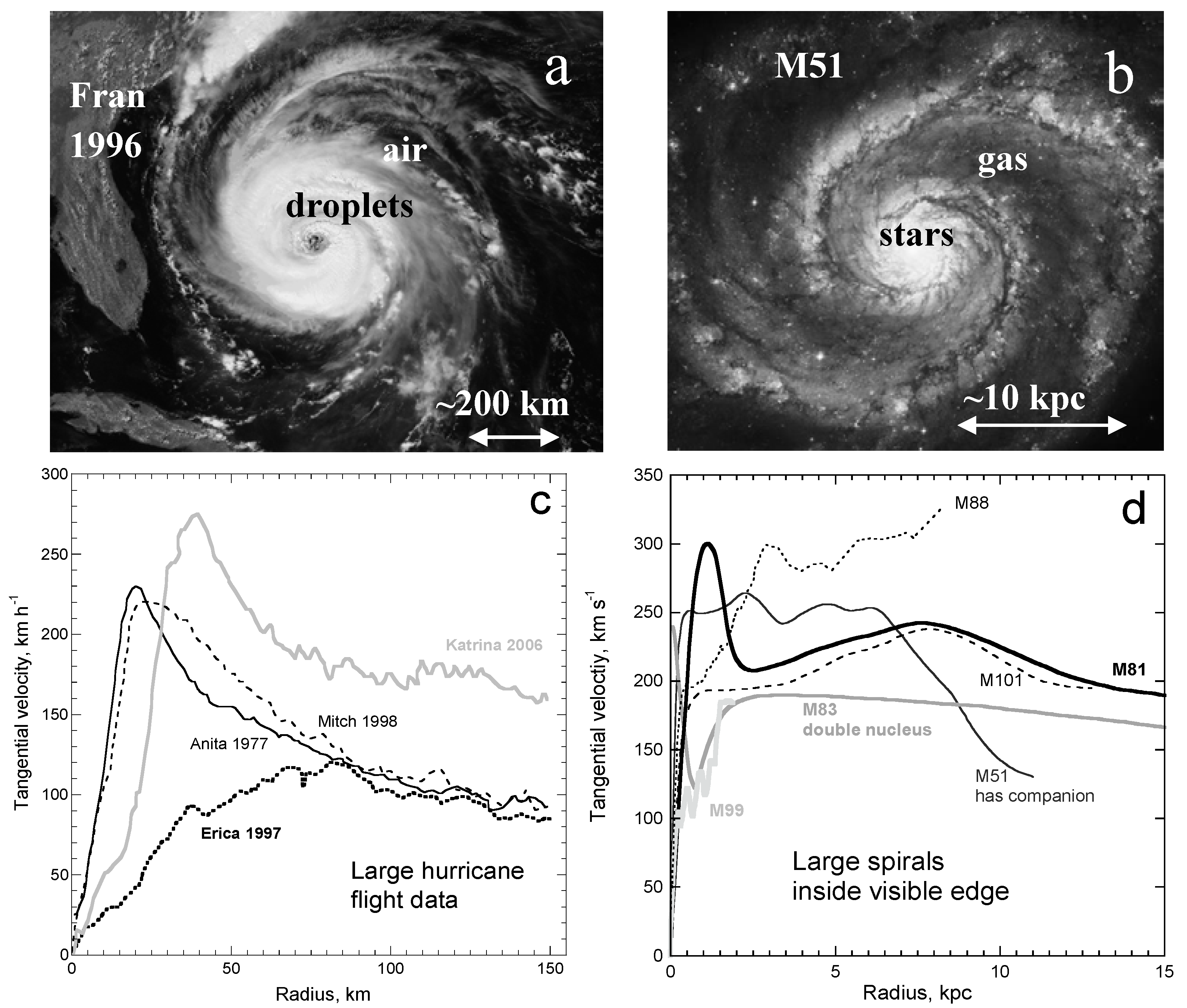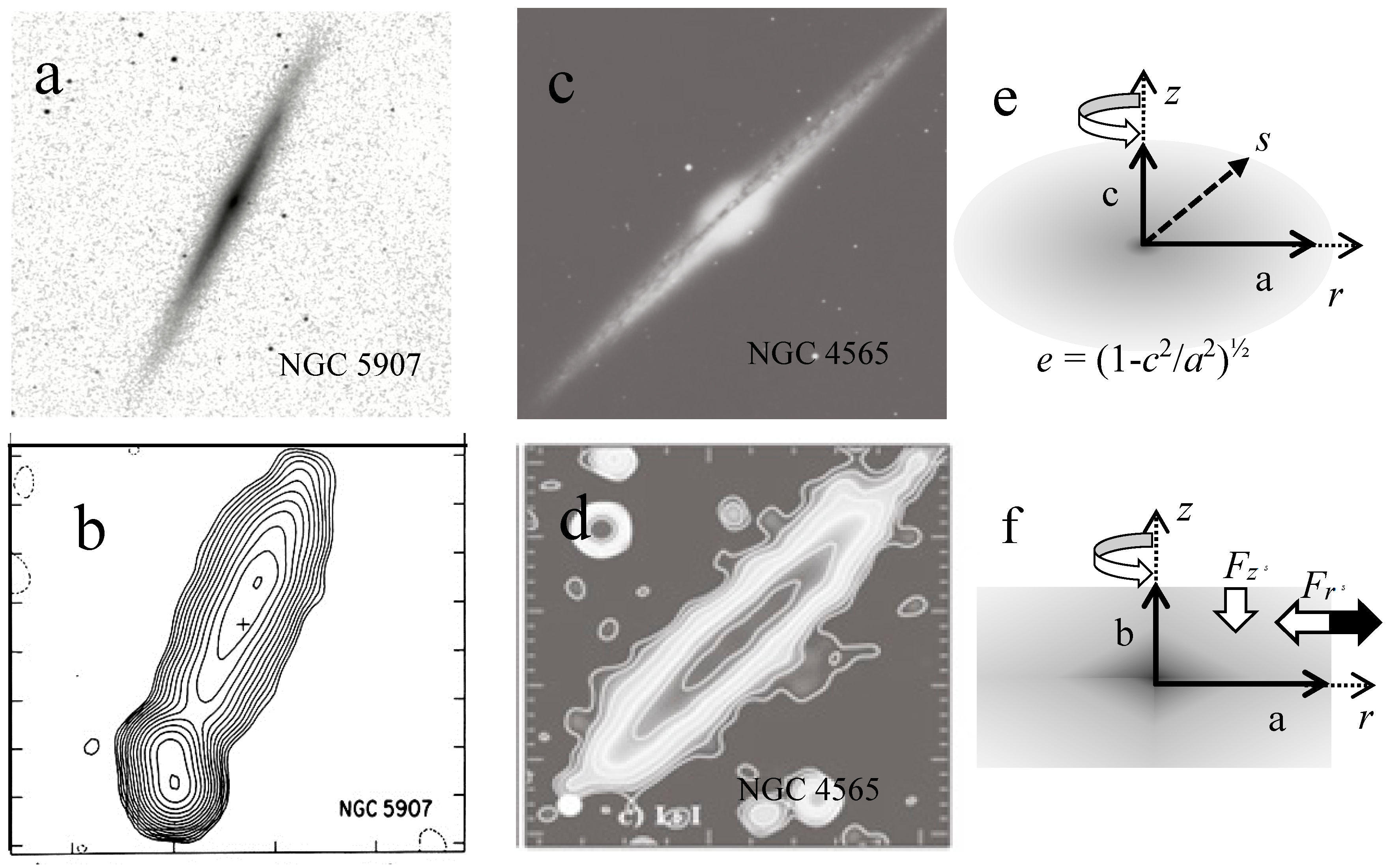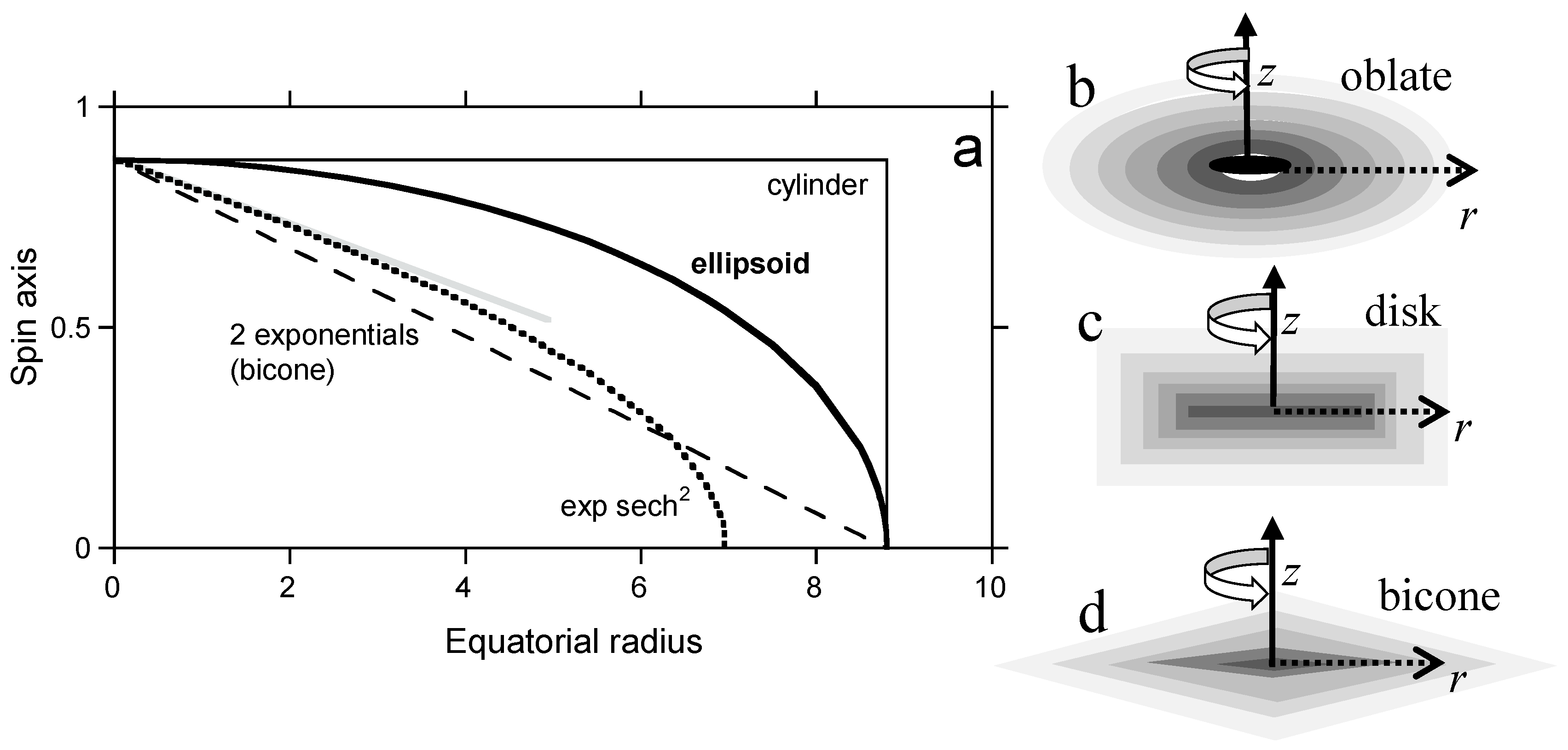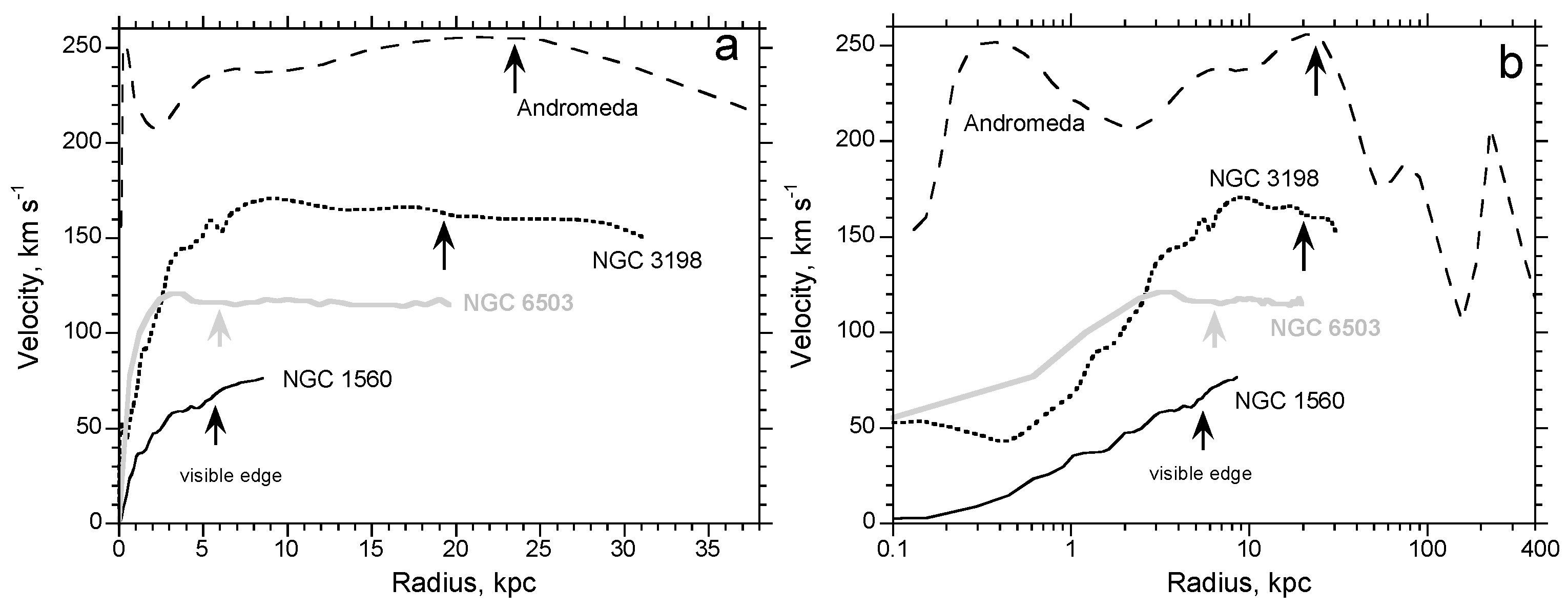Implications of Geometry and the Theorem of Gauss on Newtonian Gravitational Systems and a Caveat Regarding Poisson’s Equation
Abstract
:1. Introduction
2. Implications of Geometry on Internal Motions of Spiral Galaxies
2.1. Background: Synopsis of RC Models
2.2. Background: The Equilibrium Shape of Rotating, Gravitating Objects under Newtonian Physics
2.3. Perek’s Error
2.4. Shape Is Defined by Isodensity Surfaces, Not by the Coordinate System
2.5. Assumptions Underlying Depiction of RC as Orbits of Test Particles
- The interior mass must be spherically distributed, and not spinning, or it would be oblate.
- The orbital radius r must exceed the radius r used to compute mass, if only by a small amount (δr).
- If the satellite is sufficiently far from the galaxy (Figure 2a) for the point mass approximation to be valid, then details concerning the shape and density of the galactic interior are immaterial. Although a sufficiently distant satellite would constrain the total galactic mass, available data for extreme distances where the point mass approximation is valid are only possibly met for the Milky Way and Andromeda (Figure 5). However, their proximity alters orbits of their satellites from Keplerian.
- If the satellite is located in the interior (Figure 2b), then it can be approximated as displacing an element in the galaxy. For large r, this approximation should be reasonable because the effect on displacing interior mass is small. However, for (7) to hold requires that Mout is distributed in a spherically-symmetric manner, so that it does not affect interior orbits.
2.6. Shape and Spin
2.7. Mass Associated with Spin and Why This Differs from Mass Based on Orbiting Test Particles
3. Limitations in Applying Poisson’s Equation
3.1. Derivation of Poisson’s Equation from the Theorem of Gauss
3.1.1. Previous Derivations
3.1.2. Some Implications and an Example
3.2. Internal (Self) vs. External Potentials
3.3. Logarithmic Solutions to Poisson’s Equation Require the Line Source
3.4. Thin Disks
4. Vertical Gravitational Instability Inherent to Cylindrical Coordinates
4.1. Instability of the Thin Disk: A First Approximation
4.2. Vertical Instability of the Disk in Analytical Models of RC
5. Triggered Collapse of Nebulae to Form Planar Systems
6. Conclusions
- Use of the cylindrical coordinate system to model RC implicitly assumes that an infinite line of mass exists along z at r = 0. The large inferred mass of non-baryonic matter is closely connected with the required, but unrealistic, line source.
- Decoupling density in the z and r directions induces one unconstrained parameter in the fitting models for each of several postulated mass components. Hence, “good” fits to rotation curves involve several free parameters and do not validate RC fitting models.
- Because the calculated orbits in the equatorial plane do not account for orbital dependence on z, a hidden assumption in RC models is that rotating concentric cylinders describe galactic motions. Therefore, the assumed shape is implicitly the tall cylinder, not the flat coin.
- Density functions assumed in RC models conform to neither cylindrical, nor oblate spheroidal shapes, whereas the latter closely resembles spiral galaxies. The shapes implied by the assumed density functions are further inconsistent with the assumed moment of inertia.
- Instability exists in all RC models because the assumed isodensity surfaces are not equipotential, except in the spinning, oblate spheroid. We considered vertical stability and showed that this effect is huge. We estimate that vertical collapse would occur within about one galactic revolution.
- Because orbits are considered, neither the mass, nor density at the radius of interest are constrained.
- Importantly, Poisson’s equation is not actually used: instead the erroneous modification from [30] is employed. Referring to Poisson’s equation as the basis of RC analysis conceals the above problems. This equation describes the potential emanating from the object. Limitations that accompany use of Poisson’s equation in any application are summarized as follows:
- The potential must be computed by integrating density with respect to some specific origin, to describe how the mass around that origin affects a test particle at a distance. It is implicitly assumed that either the object is isolated, or that any mass located outside the surface is spherically distributed (if not spinning), or uniformly distributed in each shell of an oblate spheroid (if spinning).
- The density in Poisson’s equation refers to that of the interior, not ρ at the radius of interest. Equation (16b) presents a revised Poisson’s equation with average density defined in (16a) for spherical-polar coordinates. Equation (17ab) concerns cylindrical shapes and coordinates.
- As is well known, the surface of interest must enclose a finite volume, and thus, Poisson’s equation is inapplicable to the equatorial plane and to thin disks. Any such use in astrophysical problems is either invalid or implicitly assumes an infinite line source of mass along the z axis.
Acknowledgments
Author Contributions
Conflicts of Interest
References and Note
- Cotton, F.A. Chemical Applications of Group Theory; Wiley-Interscience: New York, NY, USA, 1963. [Google Scholar]
- Halliday, D.; Resnick, R. Physics; John Wiley and Sons: New York, NY, USA, 1966. [Google Scholar]
- Binney, J.; Tremaine, S. Galactic Dynamics, 2nd ed.; Princeton University Press: Princeton, NJ, USA, 2008. [Google Scholar]
- Bertin, G. Dynamics of Galaxies, 2nd ed.; Cambridge University Press: Cambridge, UK, 2014. [Google Scholar]
- Sofue, Y.; Rubin, V.C. Rotation curves of spiral galaxies. Ann. Rev. Astron. Astrophys. 2001, 39, 137–174. [Google Scholar] [CrossRef] [Green Version]
- Evans, N.W.; Bowden, A. Extremely flat halos and the shape of the galaxy. Mon. Not. R. Astron. Soc. 2014, 43, 2–11. [Google Scholar] [CrossRef]
- Sofue, Y. Dark halos of M 31 and the Milky Way. Publ. Astron. Soc. Jpn. 2015, 67, 759. [Google Scholar] [CrossRef]
- Bottema, R.; Pestaña, J.L.G. The distribution of dark and luminous matter inferred from extended rotation curves. Mon. Not. R. Astron. Soc. 2015, 448, 2566–2593. [Google Scholar] [CrossRef]
- Perek, L. Heterogeneous spheroids with Gaussian and exponential density laws. Bull. Astron. Inst. Czechoslov. 1958, 9, 208–212. [Google Scholar]
- Hofmeister, A.M.; Criss, R.E. The physics of galactic spin. Can. J. Phys. 2017, 95, 156–166. [Google Scholar] [CrossRef]
- Todhunter, I. A History of the Mathematical Theories of Attraction and Figure of the Earth; Dover Publications: New York, NY, USA, 1962. [Google Scholar]
- Faber, S.M.; Gallagher, J.S. Masses and mass-to-light ratios of galaxies. Ann. Rev. Astron. Astrophys. 1979, 17, 135–187. [Google Scholar] [CrossRef]
- Rubin, V.C.; Ford, W.K. Rotation of the Andromeda nebula from a spectroscopic survey of emission regions. Astrophys. J. 1970, 159, 379. [Google Scholar] [CrossRef]
- Ackermann, M.; Albert, A.; Anderson, B.; Baldini, L.; Ballet, J.; Barbiellini, G.; Bastieri, D.; Bechtol, K.; Bellazzini, R.; Bissaldi, E.; et al. Dark matter constraints from observations of 25 Milky Way satellite galaxies with the Fermi Large Area Telescope. Phys. Rev. D 2014, 89, 042001. [Google Scholar] [CrossRef] [Green Version]
- Brownstein, J.R.; Moffat, J.W. Galaxy rotation curves without nonbaryonic dark matter. Astrophys. J. 2006, 636, 721–741. [Google Scholar] [CrossRef]
- Kam, Z.S.; Carignan, C.; Chemin, L.; Amram, P.; Epinat, B. Kinematics and mass modelling of M33, Hα observations. Mon. Not. R. Astron. Soc. 2015, 449, 4048–4070. [Google Scholar] [CrossRef]
- Ibata, R.; Lewis, G.F.; Martin, N.F.; Bellazzini, M.; Correnti, M. Does the sagittarius stream constrain the milky way halo to be triaxial? Astrophys. J. Lett. 2013, 765, L155. [Google Scholar] [CrossRef]
- De Vega, H.J.; Salucci, P.; Sanchez, N.G. Observational rotation curves and density profiles versus the Thomas-Fermi galaxy structure theory. Mon. Not. R. Astron. Soc. 2014, 442, 2717–2727. [Google Scholar] [CrossRef]
- Ade, P.A.R.; Aghanim, N.; Armitage-Caplan, C.; Arnaud, M.; Ashdown, M.; Atrio-Barandela, F.; Aumont, J.; Baccigalupi, C.; Banday, A.J.; Barreiro, R.B.; et al. Planck 2013 results. XVI. Cosmological parameters. Astron. Astrophys. 2014, 571, A16. [Google Scholar]
- Gentile, G.; Salucci, P.; Klein, U.; Vergani, D.; Kalberla, P. Mapping the inner regions of the polar disk galaxy NGC 4650A with MUSE. Mon. Not. R. Astron. Soc. 2004, 351, 903. [Google Scholar] [CrossRef]
- Disney, M.J. Modern Cosmology, Science or Folktale? Am. Sci. 2007, 95, 383–385. [Google Scholar]
- Transtrum, M.K.; Machta, B.B.; Brown, K.S.; Daniels, B.C.; Myers, C.R.; Sethna, J.P. Perspective: Sloppiness and emergent theories in physics, biology, and beyond. J. Chem. Phys. 2015, 143, 010901. [Google Scholar] [CrossRef] [PubMed]
- McGaugh, S.S. A tale of two paradigms, the mutual incommensurability of LCDM and MOND. Can. J. Phys. 2015, 93, 250–259. [Google Scholar] [CrossRef]
- Milgrom, M. A modification of the Newtonian dynamics as a possible alternative to the hidden mass hypothesis. Astrophys. J. 1983, 270, 365–370. [Google Scholar] [CrossRef]
- Lin, H.-N.; Li, M.-H.; Li, X.; Chang, Z. Galaxy rotation curves in the Grumiller’s modified gravity. Mon. Not. R. Astron. Soc. 2013, 430, 450–458. [Google Scholar] [CrossRef]
- Clemence, G.M. The Relativity Effect in Planetary Motions. Rev. Mod. Phys. 1947, 19, 361. [Google Scholar] [CrossRef]
- Feng, J.Q.; Gallo, C.F. Mass distribution in rotating thin-disk galaxies according to Newtonian dynamics. Galaxies 2014, 2, 199–222. [Google Scholar] [CrossRef]
- Pavlovich, K.; Pavlovich, A.; Sipols, A. Newtonian explanation of galaxy rotation curves based on distribution of baryonic matter. arXiv 2014, arXiv:1406.2401P. [Google Scholar]
- Marr, J.H. Galaxy rotation curves with lognormal density distribution. Mon. Not. R. Astron. Soc. 2015, 448, 3229–3241. [Google Scholar] [CrossRef]
- Dehnen, W.; Binney, J. Mass models of the Milky Way. Mon. Not. R. Astron. Soc. 1998, 294, 429. [Google Scholar] [CrossRef]
- Moulton, F.R. An Introduction to Celestial Mechanics; MacMillan: New York, NY, USA, 1914. [Google Scholar]
- Maron, S.H.; Prutton, C.F. Fundamental Principles of Physical Chemistry; Macmillan: New York, NY, USA, 1970. [Google Scholar]
- NASA/IPAC Extragalactic Database. Available online: https://ned.ipac.caltech.edu/ (accessed on 10 May 2017).
- Dima, I.; Desflots, M. Wind Profiles in Parametric Hurricane Models; Report to Air Worldwide. 2010. Available online: www.air-worldwide.com/.../AIRCurrents-Wind-Profiles-in-Parametric-Hurricane-Models (accessed on 4 July 2017).
- Willoughby, H.E.; Darling, R.W.R.; Rahn, M.E. Parametric representation of the primary Hurricane vortex. Part II: A new family of sectionnally continuous profiles. Mon. Wea. Rev. 2006, 134, 1102–1120. [Google Scholar] [CrossRef]
- Sofue, Y.; Tutui, Y.; Honma, M.; Tomita, A.; Takamiya, T.; Koda, J.; Takeda, Y. Central rotation curves of spiral galaxies. Astrophys. J. 1999, 523, 136. [Google Scholar] [CrossRef]
- Sofue, Y.; Koda, J.; Nakanishi, H.; Onodera, S. The Virgo high-resolution CO survey, II. Rotation curves and dynamical mass distributions. Publ. Astron. Soc. Jpn. 2003, 55, 59–74. [Google Scholar] [CrossRef]
- Hofmeister, A.M.; Criss, R.E. A thermodynamic model for formation of the Solar System via 3-dimensional collapse of the dusty nebula. Planet. Space Sci. 2012, 62, 111–131. [Google Scholar] [CrossRef]
- Hofmeister, A.M.; Criss, R.E. Spatial and symmetry constraints as the basis of the virial theorem and astrophysical implications. Can. J. Phys. 2016, 94, 380–388. [Google Scholar] [CrossRef]
- Criss, R.E.; Hofmeister, A.M. Newtonian analysis of oblate spheroidal mass distributions: Inverse models of galactic rotation and determination of density distributions. Res. Astron. Astrophys. 2017. in review. [Google Scholar]
- Hofmeister, A.M.; Criss, R.E.; Criss, E.M. Verified solutions for the gravitational attraction to an oblate spheroid: Implications for planet mass and satellite orbits. Planet. Space Sci. 2017. in review. [Google Scholar]
- Dankova, T.; Rosensteel, G. Triaxial bifurcations of rapidly rotating spheroids. Am. J. Phys. 1998, 66, 1095. [Google Scholar] [CrossRef]
- Wiegert, T.; Irwin, J.; Miskolczi, A.; Schmidt, P.; Carolina Mora, S.; Damas-Segovia, A.; Stein, Y.; English, J.; Rand, R.J.; Santistevan, I. Changes in Radio continuum emission of 35 edge-on galaxies observed with the Karl G. Jansky very large array in D configuration—Data release 1. Astronom. J. 2015, 150, 81. [Google Scholar] [CrossRef]
- Schmidt, M. A model of the distribution of mass in the galactic system. Bul. Astron. Inst. Neth. 1956, 13, 15. [Google Scholar]
- Boroson, T. The distribution of luminosity in spiral galaxies. Astrophys. J. Suppl. 1981, 46, 177–209. [Google Scholar] [CrossRef]
- Freeman, K.C. On the Disks of Spiral and S0 Galaxies. Astrophys. J. 1970, 160, 811. [Google Scholar] [CrossRef]
- Sackett, P.D.; Sparke, L.S. The dark halo of the polarring galaxy NGC 4650A. Astrophys. J. 1990, 361, 408–418. [Google Scholar] [CrossRef]
- Van der Kruit, P.C.; Shostak, G.S. Vertical motion and the thickness of HI disks—Implications for galactic mass models. In Internal Kinematics and Dynamics of Galaxies; Athanassoula, E., Ed.; Kluwer: Boston, MA, USA, 1983; pp. 69–76. [Google Scholar]
- Jardel, J.R.; Gebhardt, K.; Shen, J.; Fisher, D.B.; Kormendy, J.; Kinzler, J.; Lauer, T.R.; Richstone, D.; Gültekin, K. Orbit-based dynamical models of the Sombrero galaxy (NGC 4594). Astrophys. J. 2011, 739, 21. [Google Scholar] [CrossRef]
- De Blok, W.J.G.; Walter, F.; Brinks, E.; Trachternach, C.; Oh, S.-H.; Kennicutt, R.C., Jr. High-resolution rotation curves and galaxy mass models from THINGS. Astrophys. J. 2008, 136, 2648. [Google Scholar] [CrossRef]
- Wiegert, T.; English, J. Kinematic classification of non-interacting spiral galaxies. New Astron. 2014, 26, 40–61. [Google Scholar] [CrossRef]
- Diaz, R.A.; Herrera, W.J.; Martinez, R. Moments of inertia for solids of revolution and variational methods. Eur. J. Phys. 2006, 27, 183–192. [Google Scholar] [CrossRef]
- Lelli, F.; McGaugh, S.S.; Schombert, J.M. SPARC: Mass models for 175 galaxies with Spitzer photometry and accurate rotation curves. Astrom. J. 2016, 152, 157. [Google Scholar] [CrossRef]
- Garland, G.D. The Earth’s Shape and Gravity; Pergamon Press: Oxford, UK, 1977. [Google Scholar]
- Chemin, L.; Huré, J.-M.; Soubiran, C.; Zibetti, S.; Charlot, S.; Kawata, D. Asymmetric mass models of disk galaxies—I. Messier 99. Astron. Astrophys. 2016, 588, A48. [Google Scholar] [CrossRef]
- Two approaches are described in recent studies. Sofue (Ref. [7]) computes mass from assumed density functions and sums the masses in accord with the Keplerian balance of forces in Equation (7), which presumes incorrectly that the reduced 2-body problem holds for a galaxy. Most authors (Kam et al., Ref. [16]; Chemin et al., Ref. [55]) used density to compute potentials, infer a gravitational force, use a balance with centrifugal forces to compute velocities and then sum these velocities. This procedure is equivalent to applying the superposition principle to Poisson’s equation. Other papers directly state that superposition (i.e., Equation (11)) is used (e.g., Ibata et al., Ref. [17]). Superposition appears to have originated in the 1990s, with Ref. [30].
- Pinsky, M.A. Introduction to Partial Differential Equations; McGraw-Hill: New York, NY, USA, 1984. [Google Scholar]
- Pivato, M. Linear Partial Differential Equations and Fourier Theory; Cambridge University Press: Cambridge, UK, 2010. [Google Scholar]
- Hiraski, G.J. Lecture Notes for Transport Phenomena I Fluid Dynamics. Chapter 7 Covers Poisson’s Equation in Detail. Available online: http://www.owlnet.rice.edu/~ceng501/ (accessed on 27 September 2017).
- Nordstrom, D.K.; Munoz, J.L. Geochemical Thermodynamics; Blackwell Scientific: Palo Alto, CA, USA, 1986. [Google Scholar]
- Prigogine, I.; Defay, R. Chemical Thermodynamics; Everett, D.H., Ed.; Longmans, Green, and Co.: London, UK, 1954. [Google Scholar]
- Rojansky, V. Electromagnetic Fields and Waves; Prentice-Hall, Inc.: Englewood Cliffs, NJ, USA, 1971. [Google Scholar]
- Chen, C.S.; Muleshkov, A.S.; Golbergy, M.A.; Mattheij, R.M.M. A mesh free approach to solving the axisymmetric Poisson’s equation. Numer. Methods Partial Differ. Equ. 2005, 21, 349–367. [Google Scholar] [CrossRef]
- Valtonen, M.; Karttunen, H. The Three Body Problem; Cambridge U. Press: Cambridge, UK, 2005. [Google Scholar]
- Šuvakov, M.; Dmitrišinović, V. Three classes of Newtonian three-body planar periodic orbits. Phys. Rev. Lett. 2003, 110, 114301. [Google Scholar] [CrossRef] [PubMed]
- Faris, W.G. Eprint, Lecture Notes on Partial Differential Equations. 1999. Available online: http://math.arizona.edu/~faris/lecturenotes.html (accessed on 4 July 2017).
- Kellogg, O.D. Foundations of Potential Theory; Dover Publications: New York, NY, USA, 1953. [Google Scholar]
- McCarthy, J.E.; Backhaus, E.; Fajans, J.Y. Solving Poisson’s equation with interior conditions. J. Math. Phys. 1998, 39, 6720–6729. [Google Scholar] [CrossRef]
- Emden, R. Gaskuglen—Anwendungen de Mechanischen Wärmetheorie; B.G. Teubner: Leipzig, Germany, 1907. [Google Scholar]
- Eddington, A.S. The Internal Constitution of Stars; Cambridge U. Press: Cambridge, UK, 1926. [Google Scholar]
- Safronov, V.S. Evolution of the Protoplanetary Cloud and Formation of the Earth and Planets; (Nauka, Moscow 1969: Translated by the Israel Program for Scientific Translations; NASA TT-677); Keter Publishing House: Jerusalem, Israel, 1972. [Google Scholar]
- Kenyon, S.J.; Bromley, B.C. Terrestrial planet formation. Astron. J. 2006, 131, 1837. [Google Scholar] [CrossRef]
- Armitage, P.J. Dynamics of Protoplanetary Disks. Ann. Rev. Astron. Astrophys. 2011, 49, 195–236. [Google Scholar] [CrossRef]
- Hofmeister, A.M.; Criss, R.E. Origin of HED meteorites from the spalling of Mercury: Implications for the formation and composition of the inner planets. In New Achievements in Geoscience; Hwee-San, L., Ed.; InTech: Rijeka, Croatia, 2012; pp. 153–178. [Google Scholar]






| Shape | I, Solid Body | I, Shell | Definition of R |
|---|---|---|---|
| bicone | 3/10 MR2 | ½ mR2 | cone base radius |
| sphere | ⅖ MR2 | ⅔ mR2 | body radius |
| oblate | ⅖MR2 | ⅔ mR2 | equatorial radius |
| cylinder or disk | ½ MR2 | mR2 (open ends) | body radius |
| box (square ends) | ⅔ MR2 | 4/3 mR2 (open ends) | ½ edge |
| thin ring or point | - | mR2 | radius |
© 2017 by the authors. Licensee MDPI, Basel, Switzerland. This article is an open access article distributed under the terms and conditions of the Creative Commons Attribution (CC BY) license (http://creativecommons.org/licenses/by/4.0/).
Share and Cite
Hofmeister, A.M.; Criss, R.E. Implications of Geometry and the Theorem of Gauss on Newtonian Gravitational Systems and a Caveat Regarding Poisson’s Equation. Galaxies 2017, 5, 89. https://doi.org/10.3390/galaxies5040089
Hofmeister AM, Criss RE. Implications of Geometry and the Theorem of Gauss on Newtonian Gravitational Systems and a Caveat Regarding Poisson’s Equation. Galaxies. 2017; 5(4):89. https://doi.org/10.3390/galaxies5040089
Chicago/Turabian StyleHofmeister, Anne M., and Robert E. Criss. 2017. "Implications of Geometry and the Theorem of Gauss on Newtonian Gravitational Systems and a Caveat Regarding Poisson’s Equation" Galaxies 5, no. 4: 89. https://doi.org/10.3390/galaxies5040089




